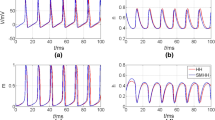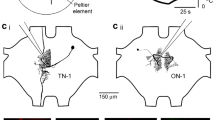Conclusions
-
1.
The ionic mechanisms of the plasticity of two types of neurons in the brain of the edible snail: habituating (HC) and nonhabituating (NHC), to rhythmic intracellular stimulation were investigated.
-
2.
It was shown that the development of habituation of HC is due to the entrance of Ca2+ into the cell and its activation of the Ca-dependent K-conductivity of the membrane, resulting in hyperpolarization, a decrease in Rin, and turnoff of the spike response to stimulation. Suppression of the Ca2+-dependent K-conductivity by quinine entirely blocks the ability of the HC for habituation.
-
3.
The data obtained on NHC are evidence that their nonhabituation to intracellular stimulation is a result of the absence of weak expression of the Ca-dependent K-conductivity in their membrane. After entering the cell, Ca2+ can have a depolarizing effect upon stimulation of the electrical activity of the NHC and can cause effects of facilitation, i.e., increase the responses to stimulation.
Similar content being viewed by others
Literature cited
V. S. Al'gul'yan, T. N. Grechenko, and E. N. Sokolov, “Influence of the parameters of electrical stimuli on the endoneuronal plasticity of isolated neurons of the edible snail,” Zh. Vyssh. Nervn. Deyat.,28, No. 4, 851 (1978).
P. M. Balaban, “Sensitization and habituation in command neurons of the defensive reflex of the edible snail,” Zh. Vyssh. Nerv. Deyat.,28, No. 2, 356 (1978).
T. N. Grechenko and E. N. Sokolov, “Endoneuronal plasticity of isolated neurons of the edible snail,” Zh. Vyssh. Nervn. Deyat.,29, No. 5, 1093 (1979).
P. A. Doroshenko and A. E. Marynyuk, “Mechanism of the blocking action of intracellular fluorine on the calcium entering current in the somatic membrane of mollusk neurons,” Dokl. Akad. Nauk SSSR,265, No. 4, 996 (1982).
T. L. D'yakonova, “Plasticity of the electroexcitable membrane: blocking by quinine of habituation of the neuron to rhythmic intracellular stimulation,” Dokl. Akad. Nauk SSSR.277, No. 1, 240 (1984).
T. L. D'yakonova and I. E. Mikhal'tsev, “Change in the input resistance and membrane potential of the neuron during the formation of a trace,” Fiziol. Zh. SSSR,69, No. 6, 795 (1983).
T. L. D'yakonova and T. M. Turpaev, “Plasticity of the electroexcitable membrane: the possible role of calcium ions,” Doki. Akad. Nauk SSSR,271, No. 5, 1261 (1983).
P. G. Kostyuk and O. A. Kryshtal', Mechanisms of the Electrical Excitability of the Nerve Cell [in Russian], Nauka, Moscow (1981).
B. S. Osipov, Functional Plasticity of Mollusk Neurons [in Russian], Izd. LGU, Leningrad (1980).
A. S. Pivovarov and V. I. Gusel'nikov, “Changes in the input resistance of the neuron and threshold of stimulation of its electroexcitable membrane by depolarizing current during the process of habituation,” Zh. Vyssh. Nervn. Deyat.,29, No. 3, 619 (1979).
D. A. Sakharov, The Genealogy of Neurons [in Russian], Nauka, Moscow (1974).
L. E. Tsitolovskii and O. I. Tsaturyan, “Selective lowering of the excitability of a neuron in the process of habituation,” Zh. Vyssh. Nervn. Deyat.,28, No. 1, 25 (1978).
D. L. Elkon, “Learning in the marine snail,” V Mire Nauki, No. 9, 34 (1983).
M. Armando-Hardy, J. C. Ellory, H. G. Ferreria, S. Flemingen, and V. L. Lew, “Inhibition of the calcium-induced increase in the potassium permeability of human red blood cells by quinine,” J. Physiol. (Engl.),250, No. 1, 32 (1975).
F. Brink, “The role of calcium in neural processes,” Pharmacol. Rev.,6, 243 (1954).
M. Galvan, G. T. Bruggencote, and R. Senekowitsch, “The effect of neuronal stimulation and ouabain upon extracellular K+ and Ca2+ levels in rat isolated sympathetic ganglia,” Brain Res.,160, No. 3, 544 (1979).
A. Gorman and A. Herman, “Quantitative differences in the currents of bursting and beating molluscan pacemaker neurons,” J. Physiol. (Engl.),333, 681 (1982).
R. D. Hawkins, T. W. Abrams, T. J. Carew, and E. R. Kandel, “A cellular mechanism of classical conditioning inAplysia; activity-dependent amplification of presynaptic facilitation,” Science,219, No. 4583, 400 (1983).
G. Hoyle, “Instrumental conditioning of the leg lift in the locust,” Neurosci. Res. Prog. Bull.,17, No. 2, 577 (1979).
M. Klein and E. Kandel, “Mechanism of calcium current modulation underlying presynaptic facilitation and behavioral sensitization inAplysia,” Proc. Natl. Acad. Sci. USA,77, No. 11, 6912 (1980).
K. Krnjevic and A. Lisiewicz, “Injection of calcium ions into spinal motoneurons,” J. Physiol. (Engl.),225, No. 2, 363 (1972).
R. W. Meech, “The sensitivity ofHelix aspersa neurons to injection of calcium ions,” J. Physiol. (Engl.),237, No. 2, 259 (1974).
R. Pumain and J. Kurcewicz, “Fast extracellular calcium transients involvement in epileptic processes,” Science,222, No. 4620, 177 (1983).
S. H. Thompson and R. W. Aldrich, “Membrane potassium currents,” in: The Cell Surface and Neural Function, Vol. 6, North-Holland, Amsterdam (1980), p. 49.
Author information
Authors and Affiliations
Additional information
Translated from Zhurnal Vysshei Nervnoi Deyatel'nosti imeni I. P. Pavlova, Vol. 35, No. 3, pp. 552–560, May–June, 1985.
Rights and permissions
About this article
Cite this article
D'yakonova, T.L. Two types of neurons differing in plastic properties: Study of ionic mechanisms. Neurosci Behav Physiol 16, 277–284 (1986). https://doi.org/10.1007/BF01148167
Received:
Issue Date:
DOI: https://doi.org/10.1007/BF01148167




